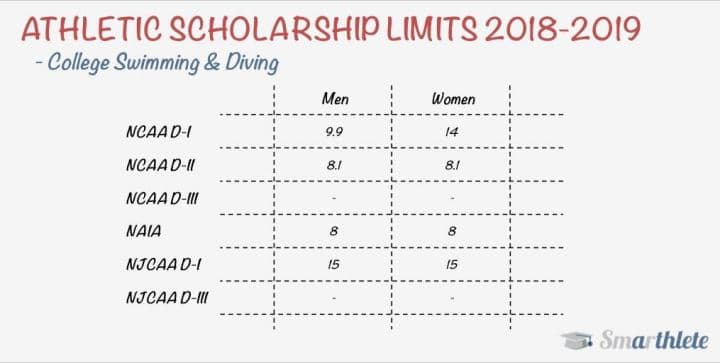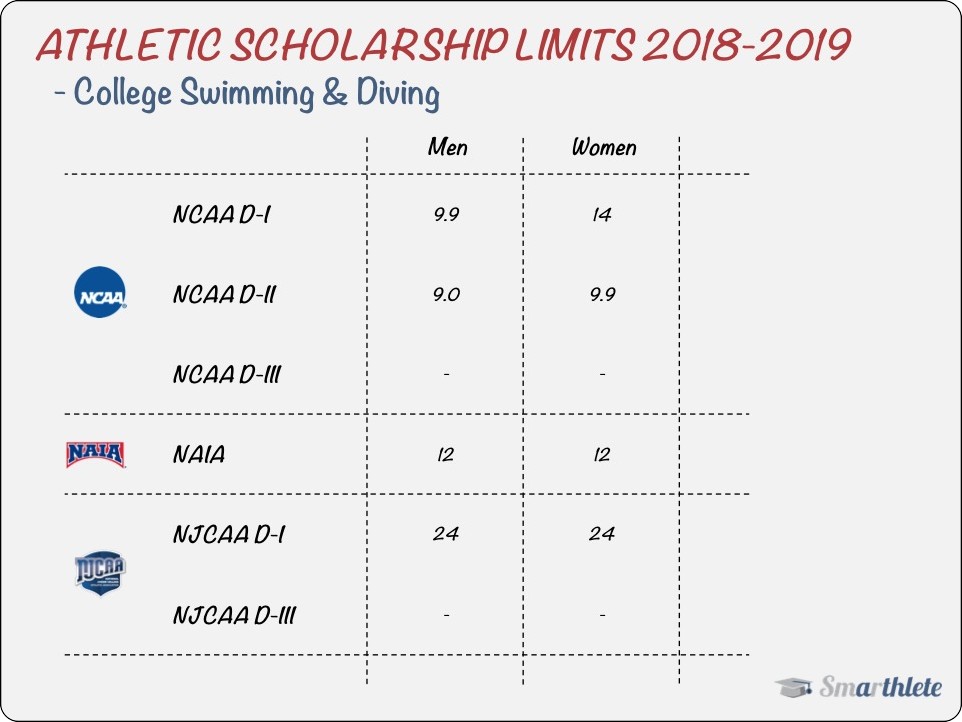Number of Scholarships in College Swimming & Diving

If you have what it takes to swim on the collegiate level, you should definitely go for it.
If you have come to the conclusion that you'd be strong enough, chances are you could qualify for an athletic scholarship offer from a number of swim teams. The important point is knowing which teams you'd be interesting for, but also to get an understanding of which universities actually do award athletic scholarships.
Hold on a sec. Don't all college coaches have a scholarship budget?
Types of Scholarships
A really important first thing to keep in mind is the following: not all divisions, sponsoring college swimming, offer athletic scholarships. Of course, it can still be a fantastic place to go, study and compete on the collegiate level, but the institution simply doesn't have any athletic scholarship funds available. Many of these schools still offer attractive and generous academic scholarship packages, if you have applications in place, which support getting such an offer. And just for the record: an academic scholarship offer from one school can end up being worth much more than receiving an athletic scholarship offer from another school. Surprised? Well, reason to read on ...
There are 6 large divisions in college swimming:
- NCAA D1
- NCAA D2
- NCAA D3
- NAIA
- NJCAA D1
- NJCAA D3
Note that NCAA D3 schools and NJCAA D3 schools don't have any sports scholarships available!
Swimming is an equivalency sport. Different from headcount sports (e.g. women's tennis), coaches may distribute their available scholarship budget to as many players as they like. In other words they can split the scholarships and award more players with smaller scholarships. We will have a detailed look at what that means in a little bit.
Scholarship Limits in College Swimming & Diving
The above divisions set clear rules as to how much scholarship money may be made available by the athletic program to the various recruits. The graphic below shows you the maximum number of scholarships, a swim coach could have to work with. Note that the athletic department could also decide to give the coaching staff less budget than the maximum permissible amount. If that is the case, this is often part of the reason why certain universities are able to attract stronger athletes, compared to other colleges:

- NCAA D1 men's swimming allows a limit of 9.9 scholarships per team.
- NCAA D1 women's swimming allows a limit of 14 scholarships per team.
- NCAA D2 allows a limit of 8.1 scholarships per team, both in men's and women's swimming.
- NAIA allows a limit of 8 scholarships per team, both in men's and women's swimming.
- NJCAA D1 allows a maximum limit of 15 scholarships, both in men's and women's swimming.
What if you get a scholarship offer, which covers around 50% of the cost of attendance? Could you be offered other forms of financial aid by the university? The answer is yes, IF you fulfil the school's criteria, such as being a strong student (GPA, SAT, ACT).
What Is An Athletic Scholarship Worth?
What's the value of a scholarship and what does it cover?
The scholarship covers a number of different costs, although the definition differs somewhat between the various governing associations.
- According to NCAA rules, a full scholarship covers "tuition & fees, room & board and course-related books".
- According to NAIA rules, a full scholarship covers tuition, mandatory fees, books & supplies required for courses in which the student-athlete is enrolled, and room & board.
- According to NJCAA rules, a full scholarship covers tuition & fees, room & board and course-related books (+ up to 250 USD of course material of & one-time transportation to and from the college per academic year).
Simply put, if you are the recipient of a full scholarship in swimming, your total costs of attendance are covered by the school. But don't get all too excited about the idea of getting a full-ride. This is very uncommon, as only a very small percentage of athletes receives such a large scholarship offer. Read more about that here: "The Truth About Athletic Scholarships at College"
Case Examples of Swimming Scholarships
Let's have a look at 2 examples to make you understand in more detail how your scholarship search could play out:
Example 1: We're going to assume that you are a 17-year old male athlete who is among the best swimmers in the region. Unfortunately, you have limited financial support from your parents and you know that a relatively large scholarship is needed.
- One coach from a local fully-funded NCAA D1 school (in-state) has been following your results and development of your "personal bests" closely and really wants to sign you. Because she has a large number of athletes graduate the year before you'd start, she has a sizeable amount of scholarship available and decides to offer you a 90% scholarship, as your impact on her team could be very big right from the start. If you were to accept, the coach would be left with 9 scholarships, as the maximum amount in men's swimming are 9.9 scholarships.
- Another coach from a fully-funded NJCAA school wants to recruit you as well and offers a 75% scholarship. Your initial response is negative, as it seems like fairly little compared to the offer from the other coach. If you think about the price tag of these two schools to start with (Total cost of attendance: 60,000 USD vs 25,000 USD), you would quickly come to the conclusion that the offer is not so bad after all: Local NCAA D1 school would cost you 6,000 USD/year (60,000 USDx0.1), whereas the NJCAA school would cost you 6,250 USD/year (25,000 USD x 0.25). If you were to accept the offer, the coach would be left with 14.25 scholarships (see graphic above: 15 - 0.75) Do you see how the scholarship offer always depends on the total cost of the school for a full academic year? That's why it's important that you have the talk with your parents at some point early on, as regards your available budget. (More about this here: What Is Your Annual Budget?)
Whether this particular athlete would decide for Option 1 in this case or Option 2 would have a lot to do with academics, athletics, personality, gut feeling as regards the coach - because we can all agree that the difference of 250 USD will not make the big difference here :)
Example 2: Say you are a female swimmer having had good conversations with a number of coaches from NCAA D-I, NCAA D-III and NAIA schools. Something that makes you stand out from the crowd are your academic achievements, as well as your ambitions - you have talked about getting your undergrad degree, go to grad school and thereafter go into research.
- Coach A from a D-I school, which is not fully funded offers you a scholarship, covering about 50% of the total cost to you. The coach has 10 scholarships available, which are 4 less than other D1 schools may have. If you accept the offer, the coach would be left with 9.5 more scholarships to distribute among his players.
- Because academics really matters to you, you are not only open to considering D3 schools, you have also understood that you may qualify for other kinds of financial aid. Coach B from a top-notch liberal arts school has established contact with you and the team happens to be among the Top 10 swim teams in the country. We're not talking any athletic scholarship offer, as it's a D3 school, but the coach has let you know that you could qualify for a rather generous financial aid offer, if you were to submit a strong application.
- Last but not least, Coach C from a NAIA team (fully-funded) doesn't have the largest amount of money left, because only 3 players graduate the year before you'd start. He can offer you a third of a scholarship and the school costs 45,000 USD/year. This leaves you with 30,000 USD to pay for Year 1 and the coach has the rest of his scholarship money (8 - 0.33 = 7.66 scholarships) tied up among other athletes on the team. He emphasizes however that you can expect a significant raise in Year 2, as the team will be losing a few athletes after your first year and quite some scholarship money gets released. Chances are your decision will not be about money only, but rather where you see yourself develop into who you want to be: a successful researcher, who loves the sport and wants to become a successful student athlete. The coaches have completely different departure points from a scholarship perspective, which leads to an interesting mix of offers ....
Key Things to Remember - College Swimming & Diving
Here are a few things to keep in mind:
- Domestic students & international students
There is an important difference depending on where you come from, even for American students. Schools' tuition fees differ for US students - whether they study at a college within their state of residency (in-state) or in another state (out-of-state) - and international students. The cheapest option is to enrol at college in the state of residency. - Scholarship agreement
While scholarships are only awarded for one academic year, scholarship agreements are typically extended year after year at the end of the season and cover the full four years of the students' eligibility. Having said that, it's not uncommon that you may "earn" more scholarship money if you perform well on the team. - Scholarship availability
Keep in mind that college swim teams consist of a very large number of athletes. In most cases the team would consist of roughly 25% freshmen, 25% sophomores, 25% juniors and 25% seniors. As a result, there is only so much scholarship money available for the coach to give away, depending on the age structure of the team. Say for example, there are only 2-3 seniors on the team: there would only be a very small amount of scholarship money that gets released once they graduate. A team with 6-8 seniors? Lovely, there might be a nice amount of scholarship money available as the coach needs to replace his graduates!
Now that you've gotten a better understanding of the number of scholarships in college swimming as well as how all of that actually plays out, you should be well-equipped for getting started with your college recruiting process.
Look no further: here on Smarthlete you can either sign up with a free recruiting profile and try get in contact with coaches all by yourself or you let our recruiting experts help you through the process!
Get started by completing our Evaluation Form and let's have a chat about how we can help you get recruited to your dream school! :)